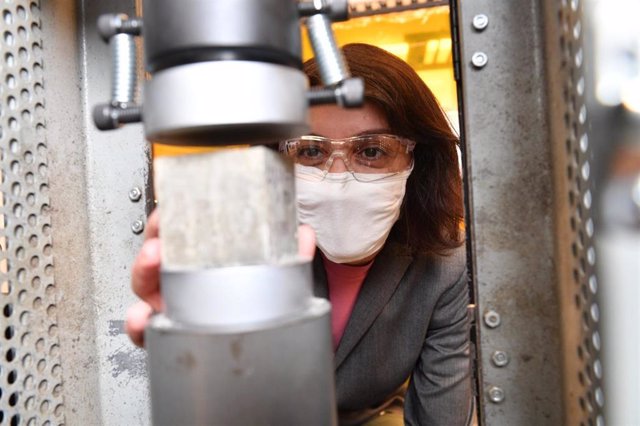Somayeh Nassiri and Li Hui measure the properties of cement formulations containing chitin nanoparticles. -WSU
Aug. 2 () –
The addition of nanoparticles of shrimp shells significantly strengthens the cementa breakthrough that would reduce shellfish waste and the carbon footprint of cement production.
In a report published in the journal Cement and Concrete Composites, a team of researchers from Washington State University (WSU) and the Pacific Northwest National Laboratory created nanocrystals and nanofibers from chitin, the second most abundant biopolymer in nature, from waste shrimp shells.
When these tiny chitin fragments, which are about 1,000 times smaller than a human hair, were added to cement paste, the resulting material was up to 40% stronger. The set time for the cement, or how long it takes to harden, was also delayed by more than an hour, a desired property for long-distance transportation and hot-weather concrete work.
“The concrete industry is under pressure to reduce its carbon emissions from cement production,” he said. it’s a statement Somayeh Nassiri, an associate professor at the University of California, Davis, who led the research at WSU. “By developing these novel cement strength-enhancing additives, we can help reduce the amount of cement required and lower carbon emissions from concrete.”
Concrete is used around the world in critical infrastructure such as buildings, bridges, and roads. It is the most used material on earth after water. Cement production is carbon intensive, which requires the use of fossil fuels to reach the required high temperatures (1,500°C). The limestone used in its production also goes through a decomposition that produces additional carbon dioxide. Cement production comprises about 15% of industrial energy consumption and about 5% of total greenhouse gas emissions worldwide. The high consumption of the material is also due in part to the challenge of durability: cement cracks easily and must be repaired or replaced frequentlyNassiri says.
Meanwhile, shellfish waste is a major problem for the fishing industry, which generates four million tons of waste annually worldwide. Most of that waste is dumped into the sea, says Hui Li, a research assistant professor in the WSU Center for Engineering and Composite Materials and the paper’s corresponding author.
Researchers have worked to improve cement with a similar common biopolymer, cellulose. Sometimes the cellulose additives would help the concrete and sometimes they wouldn’t. The researchers were puzzled as to why.
In their work, the WSU team studied chitin materials at the nanoscale. The shells of crabs, shrimp and lobsters are made up of about 20-30% chitin with much of the rest being calcium carbonate, another useful additive to cement. Compared to cellulose, chitin on a molecular scale has an additional set of atoms, a functional group, which allows researchers to control the charge on the surface of the molecules and consequently, how they behave in the cement grout.
Success in strengthening the cement paste came down to how the particles are suspended within the cement slurry and how they interact with the cement particles.
“Chitin nanoparticles repel individual cement particles sufficiently as to change the hydration properties of the cement particle within the system“, said.
As they added the processed chitin nanocrystals to the cement, they were able to enhance and focus its properties, including its consistency, setting time, strength and durability. They saw a 40% increase in resistance to how concrete can bend and a 12% improvement in the ability to compress it.
“Those are very significant numbers,” Wolcott said. “If you can reduce the amount you use and get the same mechanical function or structural function and double its lifespan, then you can significantly reduce carbon emissions from the built environment.”
The researchers now hope to scale up the work to start producing the additive on a large scale. Research must also continue to achieve the same level of improvements seen at the cement paste scale at the concrete scale.
















Add Comment